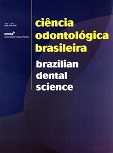Avaliação da superfície dental após procedimentos de raspagem e aplainamento radicular: estudo in vitro
DOI:
https://doi.org/10.14295/bds.2006.v9i1.264Abstract
O objetivo deste estudo in vitro foi avaliar a superfície dental por meio de microscopia eletrônica de varredura quanto a presença de cálculo e cemento residual, após a realização de raspagem e aplainamento radicular (RAR) variando força e movimento. Para tanto, foram utilizados 12 dentes unirradiculares, com cálculo aderido à superfície radicular e 12 curetas Gracey 5-6 (Hu-Friedy®) adaptadas a um Dispositivo de Tração Controlada (DTC) que simula a RAR. O DTC permitiu o controle da força (3, 8 e 13N) e do número de movimentos (cinco, dez, 15 e vinte) aplicados durante a instrumentação radicular. A componente Força foi avaliada estatisticamente por ANOVA e t de Student (p<0,05), enquanto o número de movimentos foi comparado entre grupos por Wilcoxon (p<0,05). Os resultados mostraram que quanto maior a força Aplicada menor a quantidade de cálculo e cemento residual (3/8N: p=0,0001) e (8/13N: p=0,0021), todavia, 15 e vinte Movimentos mostraram diferença marginalmente significativa (p=0,0679). Estes movimentos removeram maiores quantidades de cálculo e cemento em relação a cinco e dez movimentos (p=0,0001). A partir do presente estudo pode-se concluir que quanto maior a força aplicada maior a quantidade de cálculo e cemento removida. Por outro lado, a partir de determinado número de repetições (n=15), o aumento destas não trouxe benefícios adicionais quanto à remoção de cálculo e cemento radicular.Downloads
Downloads
Published
How to Cite
Issue
Section
License
Brazilian Dental Science uses the Creative Commons (CC-BY 4.0) license, thus preserving the integrity of articles in an open access environment. The journal allows the author to retain publishing rights without restrictions.
=================




























